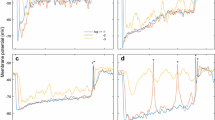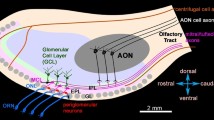Summary
Intracellular recording and staining techniques revealed new aspects of the anatomy and physiology of ocellarl-neurons in the honeybee (Apis mellifera).
Structural comparisons of homologous identifiedl-neurons showed that their axon pathways and projection areas in the brain were similar, whereas somata location and terminal branching patterns differed.
l-neuron responses to light ranged from graded reponses with fast on- and off-transients to inhibition of spontaneous discharge. Since the same morphological type ofl-neuron responded differently in different animals, response types could not be correlated systematically with morphology. However, purely graded responses were not found in extrinsicl d -neurons, and lateral ocellar L-neurons never exhibited an inhibition of the tonic spike discharge without a graded component.
l-neuron graded responses could be elicited only by light stimulation of the ocelli, but not by moving striped patterns, polarised white light, light stimuli to the compound eyes, airpuffs, or odor stimuli.
Various parameters of the graded response code light intensity differently. Response/intensity functions rise over an intensity range of 5 log units to saturate at higher intensities. The spectral sensitivity has two peaks close to 340 nm and 500 nm.
Similar content being viewed by others
References
Autrum H, Metschi N (1963) Die Arbeitsweise der Ocellen der Insekten. Z Vergl Physiol 47:256–273
Chappell RL, Dowling JE (1972) Neural organization of the median ocellus of the dragonfly. I. Intracellular electrical activity. J Gen Physiol 60:121–147
Geiser FX, Labhart T (1982) Elektrophysiologische Untersuchungen an der Ocellen-Retina der Honigbiene (Apis mellifera). Verh Dtsch Zool Ges 75:307
Goldsmith TH, Ruck PR (1958) The spectral sensitivities of the dorsal ocelli of cockroaches and honeybees. J Gen Physiol 41:1171–1185
Goodman CS (1974) Anatomy of locust interneurons: Constancy and variability. J Comp Physiol 95:185–201
Goodman CS (1976) Anatomy of the ocellar interneurons of acridid grasshoppers. I. The large interneurons. Cell Tissue Res 175:184–203
Goodman CS (1977) Neuron duplications and deletions in locust clones and clutches. Science 197:1384–1386
Goodman CS (1978) Isogenic grasshoppers: Genetic variability in the morphology of identified neurons. J Comp Neurol 182:681–706
Goodman CS, Pearson KG, Heitier WJ (1979) Variability of identified neurons in grasshoppers. Comp Biochem Physiol 64A: 455–462
Goodman LJ (1970) The structure and function of the insect dorsal ocellus. Adv Insect Physiol 7:97–195
Goodman LJ (1981) Organisation and physiology of the insect dorsal ocellar system. In: Autrum H (ed) Handbook of sensory physiology, vol VII/6C. Springer, Berlin Heidelberg New York, pp 201–286
Gould JL (1975) Honeybee recruitment: The dance-language controversy. Science 189:685–693
Guy RG, Goodman LJ, Mobbs PG (1979) Visual interneurons in the bee brain: Synaptic organization and transmission by graded potentials. J Comp Physiol 134:253–264
Klingman A, Chappell RL (1978) Feedback synaptic interaction in the dragonfly ocellar retina. J Gen Physiol 71:157–175
Kral K (1978) Die Orientierung der Rhabdome in den Ocellen der HonigbieneApis mellifera carnica Pollm und der ErdwespeVespa vulgaris L. Zool Jb Physiol 82:263–271
Laughlin SB (1981) Neural principles in the peripheral visual system of invertebrates. In: Autrum H (ed) Handbook of sensory physiology, vol VII/6B. Springer, Berlin Heidelberg New York, pp 133–280
Menzel R, Erber J (1978) Learning and memory in bees. Sci Am 239:102–110
Milde JJ (1981a) Graded potentials and action potentials in the large ocellar interneurons of the bee. J Comp Physiol 143:427–434
Milde JJ (1981b) Response characteristics of identified interneurons in the ocellar system of the bee. Verh Dtsch Zool Ges 74:178
Milde JJ (1982) Elektrophysiologische und anatomische Untersuchungen an Interneuronen erster und höherer Ordnung des Ocellensystems der Biene. Ph D thesis, Freie Universität Berlin
Mizunami M, Yamashita S, Tateda H (1982) Intracellular stainings of the large ocellar second-order neurons in the cockroach. J Comp Physiol 149:215–219
Mobbs PG, Guy RG, Goodman LJ, Chappell RL (1981) Relative spectral sensitivity and reverse Purkinje shift in identifiedl-neurons of the ocellar retina. J Comp Physiol 144:91–97
Pan KC (1981) The neural organization of the ocellar system and associated pathways in the central nervous system of the worker honeybee,Apis mellifera. PhD thesis, University of London
Pan KC, Goodman LJ (1977) Ocellar projections within the central nervous system of the worker honeybee (Apis mellifera). Cell Tissue Res 176:505–527
Pappas LG, Eaton JL (1977) Large ocellar interneurons in the brain of the cabbage looper moth,Trichoplusia ni (Lepidoptera). Zoomorphologie 87:237–246
Patterson JA, Chappell RL (1980) Intracellular responses of procion filled cells and whole nerve cobalt impregnation in the dragonfly median ocellus. J Comp Physiol 139:25–39
Pearson KG, Goodman CS (1979) Correlation of variability in structure with variability in synaptic connections of an identified interneuron in locusts. J Comp Neurol 184:141–166
Rowell CHF (1971) The orthopteran descending movement detector (DMD) neurones: a characterisation and review. Z Vergl Physiol 73:167–194
Schricker B (1965) Die Orientierung der Honigbiene in der Dämmerung. Zugleich ein Beitrag zur Frage der Ocellenfunktion bei Bienen. Z Vergl Physiol 49:420–458
Simmons PJ (1981) Synaptic transmission between second- and third-order neurones of a locust ocellus. J Comp Physiol 145:265–276
Simmons PJ (1982a) Transmission mediated with and without spikes at connexions between larger second-order neurones of locust ocelli. J Comp Physiol 147:401–414
Simmons PJ (1982b) The operation of connexions between photoreceptors and large second-order neurones in dragonfly ocelli. J Comp Physiol 149:389–398
Speck PT, Strausfeld NJ (1983) Portraying the third dimension in neuroanatomy. In: Strausfeld NJ (ed) Functional Neuroanatomy. Springer, Berlin Heidelberg New York Tokyo, pp 156–182
Stange G (1981) The ocellar component of flight equilibrium control in dragonflies. J Comp Physiol 141:335–347
Steeves JD, Pearson KG (1983) Variability in the structure of an identified interneurone in isogenic clones of locust. J Exp Biol 103: 47–54
Stewart WW (1978) Functional connections between cells as revealed by dye-coupling with a highly fluorescent naphthalimide tracer. Cell 14:741–759
Strausfeld NJ (1976) Atlas of an insect brain. Springer, Berlin Heidelberg New York
Strausfeld NJ, Seyan HS, Wohlers D, Bacon JP (1983) Lucifer yellow histology. In: Strausfeld NJ (ed) Functional neuroanatomy. Springer, Berlin Heidelberg New York Tokyo, pp 132–155
Taylor CP (1981a) Graded interactions between identified neurons from the simple eyes of an insect. Brain Res 215:382–387
Taylor CP (1981b) Contribution of compound eyes and ocelli to steering of locusts in flight. I. Behavioural analysis. J Exp Biol 93:1–18
Taylor CP (1981c) Contribution of compound eyes and ocelli to steering of locusts in flight. II. Timing changes in flight motor units. J Exp Biol 93:19–31
Wilson M (1978a) The functional organization of locust ocelli. J Comp Physiol 124:297–316
Wilson M (1978b) Generation of graded potential signals in the second-order cells of locust ocellus. J Comp Physiol 124:317–331
Wilson M (1978c) The origin and properties of discrete hyperpolarizing potentials in the second-order cells of locust ocellus. J Comp Physiol 128:347–358
Author information
Authors and Affiliations
Rights and permissions
About this article
Cite this article
Milde, J.J. Ocellar interneurons in the honeybee. J. Comp. Physiol. 154, 683–693 (1984). https://doi.org/10.1007/BF01350222
Accepted:
Issue Date:
DOI: https://doi.org/10.1007/BF01350222




